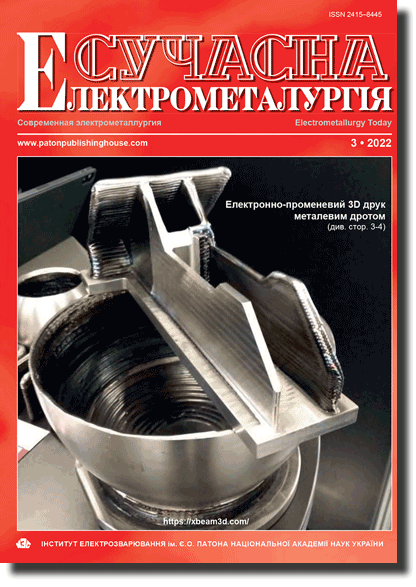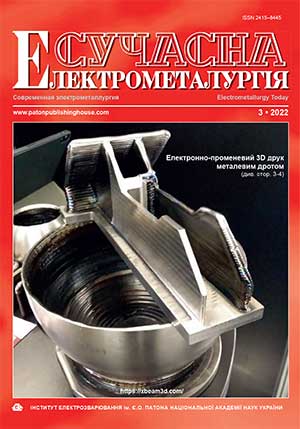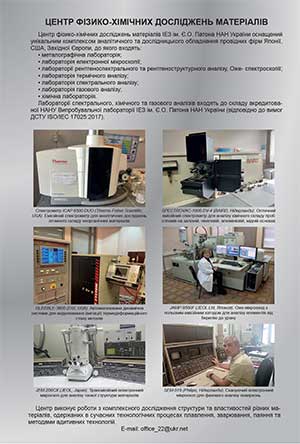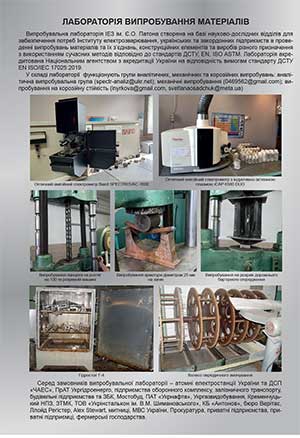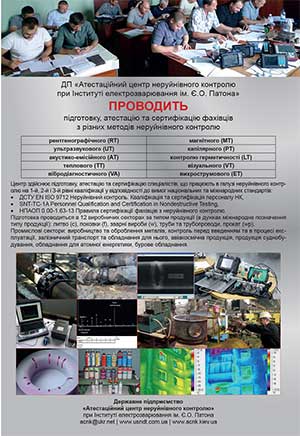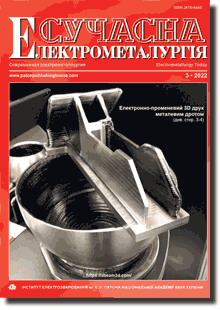
Electrometallurgy Today (Sovremennaya Elektrometallurgiya), 2022, #3, 18-22 pages
E.O. Paton Electric Welding Institute of the NAS of Ukraine. 11 Kazymyr Malevych Str., Kyiv, 03150, Ukraine. E-mail: office@paton.kiev.ua
Abstract
Different schemes of producing the effect of slag pool rotation are considered. The rationality of achieving this effect without application of additional power sources or devices for electromagnetic impact on the slag pool is shown. Experiments were conducted in two types of moulds, namely current-supplying and regular modifications. It is established that in order to achieve the defined goal it is rational to apply current-supplying moulds with one or several cuts and current-supplies in the current-supplying section. Ref. 14, Fig. 7.
Keywords: electroslag surfacing (remelting); water-cooled mould; discrete filler; rotation; slag pool
Received 30.05.2022
2. Murgash, M., Chaus, A.S. (1988) Application of magnetic field in electroslag remelting of steel. Fizika i Khimiya Obrabotki Materialov, 2, 99-107 [in Russian].
3. Protokovilov, I.V. (2011) Magnetohydrodynamic technologies in metallurgy (Review). Advances in Electrometallurgy, 4, 239-250.
4. Radchenko, A.A. (2000) Influence of external electromagnetic actions on technology of electroslag surfacing of coatings and their properties. In: Abstr. of Pap. of Int. Conf. on Welded Structures (Ukraine, Kyiv, October 2000). Kyiv, PWI, 115-116 [in Russian].
5. Dudko, D.A., Rublevsky, I.N. (1960) Electromagnetic stirring of slag and metal pool in electroslag process. Avtomatich. Svarka, 9, 12-16 [in Russian].
6. Ksyondzyk, G.V., Frumin, I.I., Shirin, V.S. Current-carrying mold. USSR author`s cert. 264427. Fill. 19.11.1964 [in Russian].
7. Ksyondzyk, G.V., Frumin, I.I., Shirin, V.S. Installation for electroslag remelting. USSR author`s cert. 337026. Fill. 25.06.1969 [in Russian].
8. Ksyondzyk, G.V., Frumin, I.I., Kuskov, Yu.M. Current-carrying sectional mold. USSR author`s cert. 1085250, Int. Cl. С22В 9/18. Fill. 30.03.1982 [in Russian].
9. Tomilenko, S.V., Kuskov, Yu.M. (2000) Special features of melting of parent metal electroslag surfacing in a current-supplying solidification mould. Welding Inter., 14(11), 893-895. https://doi.org/10.1080/09507110009549288
10. Kuskov, Yu., Tsykulenko, K.A. (2009) Conducting mold for electroslag surfacing of plane blanks. Steel Translation, 39(1), 53-58. https://doi.org/10.3103/S0967091209010136
11. Tomilenko S.V., Kuskov Yu.M. (2002) Using direct and alternating current winh reduced frequency in surfacing in sectional current-supplying solidification moulds. Welding Intern., 16(7), 572-574. https://doi.org/10.1080/09507110209549579
12. (1986) Metallurgy of electroslag remelting. Ed. by B.E. Paton, B.I. Medovar. Kyiv, Naukova Dumka [in Russian].
13. Bystrov, V.A. (2003) Fundamentals of electroslag technologies for hardening by composite alloys of parts operating at high-temperature wear: Syn. of Thesis for Cand. of Tech. Sci. Degree. Barbaul [in Russian].
14. Kuskov, Yu.M., Proskudin, V.M., Zhdanov, V.A., Okopnik, L.L. (2022) Current-supplying mould in electroslag technologies. The Paton Welding J., 7, 35-38. https://doi.org/10.37434/tpwj2022.07.06
AS = «Automatic Welding» - 6 issues per year;
TPWJ = «PATON WELDING JOURNAL» - 12 issues per year;
SEM = «Electrometallurgy Today» - 4 issues per year;
TDNK = «Technical Diagnostics and Non-Destructive Testing» - 4 issues per year.
| 2022 №03 (02) |
DOI of Article 10.37434/sem2022.03.03 |
2022 №03 (04) |

Electrometallurgy Today (Sovremennaya Elektrometallurgiya), 2022, #3, 18-22 pages
Experience of studying the effect of slag pool rotation at electroslag surfacing with a discrete filler
Yu.M. Kuskov, V.M. Proskudin, I.P. Lentyugov, V.O. Zhdanov, L.L. Okopnik
E.O. Paton Electric Welding Institute of the NAS of Ukraine. 11 Kazymyr Malevych Str., Kyiv, 03150, Ukraine. E-mail: office@paton.kiev.ua
Abstract
Different schemes of producing the effect of slag pool rotation are considered. The rationality of achieving this effect without application of additional power sources or devices for electromagnetic impact on the slag pool is shown. Experiments were conducted in two types of moulds, namely current-supplying and regular modifications. It is established that in order to achieve the defined goal it is rational to apply current-supplying moulds with one or several cuts and current-supplies in the current-supplying section. Ref. 14, Fig. 7.
Keywords: electroslag surfacing (remelting); water-cooled mould; discrete filler; rotation; slag pool
Received 30.05.2022
References
1. Kompan, Ya.Yu., Shcherbina,, E.V. (1989) Electroslag welding and melting with controlled MGD-processes. Moscow, Mashinostroenie [in Russian].2. Murgash, M., Chaus, A.S. (1988) Application of magnetic field in electroslag remelting of steel. Fizika i Khimiya Obrabotki Materialov, 2, 99-107 [in Russian].
3. Protokovilov, I.V. (2011) Magnetohydrodynamic technologies in metallurgy (Review). Advances in Electrometallurgy, 4, 239-250.
4. Radchenko, A.A. (2000) Influence of external electromagnetic actions on technology of electroslag surfacing of coatings and their properties. In: Abstr. of Pap. of Int. Conf. on Welded Structures (Ukraine, Kyiv, October 2000). Kyiv, PWI, 115-116 [in Russian].
5. Dudko, D.A., Rublevsky, I.N. (1960) Electromagnetic stirring of slag and metal pool in electroslag process. Avtomatich. Svarka, 9, 12-16 [in Russian].
6. Ksyondzyk, G.V., Frumin, I.I., Shirin, V.S. Current-carrying mold. USSR author`s cert. 264427. Fill. 19.11.1964 [in Russian].
7. Ksyondzyk, G.V., Frumin, I.I., Shirin, V.S. Installation for electroslag remelting. USSR author`s cert. 337026. Fill. 25.06.1969 [in Russian].
8. Ksyondzyk, G.V., Frumin, I.I., Kuskov, Yu.M. Current-carrying sectional mold. USSR author`s cert. 1085250, Int. Cl. С22В 9/18. Fill. 30.03.1982 [in Russian].
9. Tomilenko, S.V., Kuskov, Yu.M. (2000) Special features of melting of parent metal electroslag surfacing in a current-supplying solidification mould. Welding Inter., 14(11), 893-895. https://doi.org/10.1080/09507110009549288
10. Kuskov, Yu., Tsykulenko, K.A. (2009) Conducting mold for electroslag surfacing of plane blanks. Steel Translation, 39(1), 53-58. https://doi.org/10.3103/S0967091209010136
11. Tomilenko S.V., Kuskov Yu.M. (2002) Using direct and alternating current winh reduced frequency in surfacing in sectional current-supplying solidification moulds. Welding Intern., 16(7), 572-574. https://doi.org/10.1080/09507110209549579
12. (1986) Metallurgy of electroslag remelting. Ed. by B.E. Paton, B.I. Medovar. Kyiv, Naukova Dumka [in Russian].
13. Bystrov, V.A. (2003) Fundamentals of electroslag technologies for hardening by composite alloys of parts operating at high-temperature wear: Syn. of Thesis for Cand. of Tech. Sci. Degree. Barbaul [in Russian].
14. Kuskov, Yu.M., Proskudin, V.M., Zhdanov, V.A., Okopnik, L.L. (2022) Current-supplying mould in electroslag technologies. The Paton Welding J., 7, 35-38. https://doi.org/10.37434/tpwj2022.07.06
Advertising in this issue:
The cost of subscription/purchase order journals or individual articles
| Journal/Currency | Annual Set | 1 issue printed |
1 issue |
one article |
| AS/UAH | 1800 UAH | 300 UAH | 300 UAH | 150 UAH |
| AS/USD | 192 $ | 32 $ | 26 $ | 16 $ |
| AS/EUR | 180 € | 30 € | 25 € | 15 € |
| TPWJ/UAH | 7200 UAH | 600 UAH | 600 UAH | 280 UAH |
| TPWJ/USD | 384 $ | 32 $ | 26 $ | 16 $ |
| TPWJ/EUR | 360 € | 30 € | 25 € | 15 € |
| SEM/UAH | 1200 UAH | 300 UAH | 300 UAH | 150 UAH |
| SEM/USD | 128 $ | 32 $ | 26 $ | 16 $ |
| SEM/EUR | 120 € | 30 € | 25 € | 15 € |
| TDNK/UAH | 1200 UAH | 300 UAH | 300 UAH | 150 UAH |
| TDNK/USD | 128 $ | 32 $ | 26 $ | 16 $ |
| TDNK/EUR | 120 € | 30 € | 25 € | 15 € |
AS = «Automatic Welding» - 6 issues per year;
TPWJ = «PATON WELDING JOURNAL» - 12 issues per year;
SEM = «Electrometallurgy Today» - 4 issues per year;
TDNK = «Technical Diagnostics and Non-Destructive Testing» - 4 issues per year.




